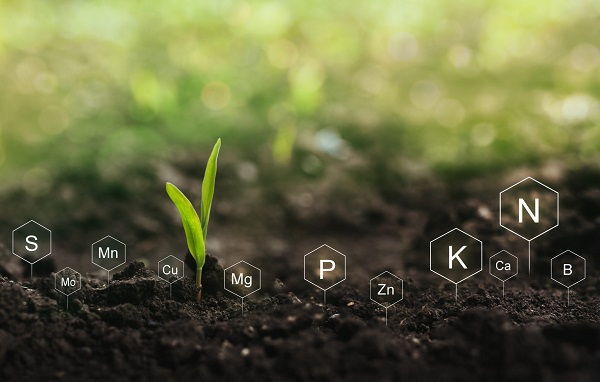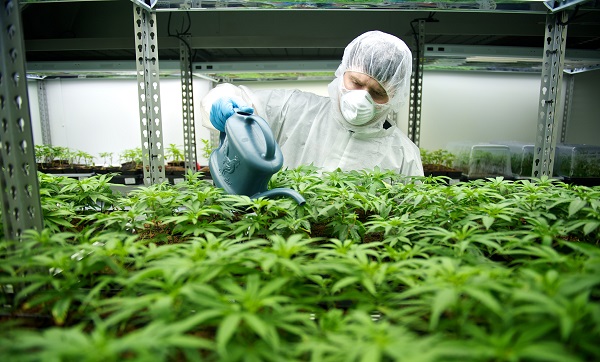Nutrients are divided into two main categories: organic and inorganic. Organic constitutes 90% to 95% of the dry weight of plants and includes carbon, oxygen and hydrogen derived from carbon dioxide in the atmosphere and water in the soil. The remaining 5-10% is represented by the mineral component.
The positive effects of applying minerals to soil, such as fireplace ash and lime in humid climates, have been known for centuries However, about 150 years ago the role of various mineral elements in plant growth was controversial.
Before methods of analyzing soil and plant tissues had been developed, it was impossible to correctly formulate early theories explaining the functions of these various nutrients and their vital importance to plant growth. As a result, an understanding of the basic elements necessary for plant growth emerged.
One of the theories that emerged from the research was the law of minimum or Libich’s law (named after the German baron and chemist Julius von Liebig) in the mid-19th century. This theory states that plant growth is determined by various factors (water, CO2, nitrogen, light, relative humidity), and if there is a lack of at least one of them, plants stop forming biomass.
In 1880 the botanist Julius von Sachs demonstrated the possibility of growing plants in a nutrient solution without using soil (hydroponics). Based on his experiments with hydroponics and subsequent analysis of plant tissues, he concluded that the presence or concentration of an element in a plant does not guarantee its necessity.
Plants do not fully discriminate nutrients when they are dense, so they can experience toxicity if harmful elements are present in the soil or nutrient solution. They can also assimilate harmless but excessive elements.
Major mineral elements

The term «essential mineral element» was introduced by American researchers Daniel Arnon and Arlow Scout in 1934. They argued that for an element to be considered essential, it must meet the following three criteria:
- A plant cannot complete its life cycle in its absence .
- The role of the element cannot be fulfilled by any other element.
- The element must take a direct part in metabolism or be necessary for a certain phase of metabolism, such as an enzymatic reaction, for example.
An element that acts as a major element or reduces the influence of a harmful element can be considered beneficial.
For higher plants, including various species of cannabis, 17 essential elements have been identified, which are divided into micro and macronutrients. As the name implies, trace elements are required for some enzymatic reactions, but without them the plant cannot complete its life cycle.
Some elements, such as nickel, sodium and silicon, are only necessary for a limited number of species, while for others they are useful.
As new methods of tissue analysis and compound production develop, the accidental addition of impurities will diminish, and perhaps this list will soon be added to. Elements not previously considered useful may be included in fertilizers as additives to the major compounds (especially with respect to trace elements).
Macronutrients

The six elements we will discuss next (N, P, K, Mg, S, Ca), along with the organic elements carbon, hydrogen and oxygen, are macronutrients. Many of them are important for the structure of molecules, and their name is due to the fact that they are needed in large quantities (their content in tissues is always above 0.1%).
Nitrogen

After water, nitrogen is the second most important for plant growth because it plays a key role in protein formation. Low nitrogen content in most types of soils, including organic soils, makes it deficient, similar to phosphorus and potassium deficiency.
Most of the nitrogen in the soil is present in organic form, which plants are unable to assimilate. Plants extract nitrate (NO3-) and ammonium (NH4+) from the soil, and can also absorb ammonia in gaseous form through the leaves in small quantities.
A special way of assimilating nitrogen is characteristic of legumes. Their roots exist in symbiosis with certain soil bacteria capable of interacting with atmospheric nitrogen (N2), which then enters the plant. The plant then converts it to its ammonium or nitrate form. The efficiency of this process depends largely on microorganisms that convert organic forms of nitrogen into assimilable forms, in a process known as mineralization.
Therefore, it is essential to maintain a stable level of nitrogen in the soil in order to stimulate plant growth. Total nitrogen content in plant dry matter varies from 1.5% to 5%.
Phosphorus
Plants assimilate phosphorus in the form of ionic phosphate compounds, mainly in the form of H2PO4 – in neutral or slightly acidic soils, and in the form of HPO4 in calcareous soils. Phosphorus in plants as phosphate in ATP (adenosine triphosphate) molecules with high energy potential plays a key role in energy exchange, respiration and photosynthesis.
In highly calcareous soils, phosphorus is poorly soluble, so it is applied as a nutrient solution (e.g., at PK 13-14). Another important absorption pathway is mycorrhizal absorption, where soil fungi dissolve and absorb phosphorus, increasing its availability and promoting plant growth.
Potassium
similar to those of nitrogen and phosphorus. Potassium actively moves from the old to the young parts of the plant, so its deficiency is most often noticeable on old or lower leaves. By regulating the opening and closing of the stomata, potassium plays a key role in the transpiration process.
In addition, potassium activates more than 50 enzyme complexes, although in some cases it can be replaced with sodium. It is also responsible for plant turgor (i.e. stiffness and strength of leaves and stems). K+ is the most abundant cation in plants, making up to 10% of their dry weight.
Sulfur

Sulfur is present in certain amino acids and a variety of enzymes, playing a key role in cellular respiration. Plants absorb sulfur in the form of sulfate SO4, which is then transported by the xylem. Sulfur can also be absorbed through the stomata of leaves in the form of sulfur dioxide, SO2 , an air pollutant produced by burning fossil fuels.
When sulfur dioxide is absorbed, the plant produces bisulfite, which displaces magnesium from the chlorophyll molecule, thus reducing photosynthesis. However, this is often compensated for by the high concentration of carbon dioxide in high-traffic areas, which mitigates the negative effects of sulfur dioxide gas. In plants, the ratio of sulfur to nitrogen is usually 1:15.
Calcium

Calcium, which is part of the cell walls in the form of calcium pectate, provides strength similar to animal bones. It also plays a role in plant adaptation to light and temperature. Calcium is absorbed in the form of the divalent Ca2+ ion, which is present in most soils. A deficiency of this element is rare, except when plants are grown on untreated peat with high acidity.
Since ancient times, lime has been added to acidic soils to improve cultivation conditions, thus confirming the importance of calcium. In hydroponic cultivation using reverse osmosis water, calcium deficiency can cause poor root growth. The concentration of calcium in plants is about 1% of dry matter.
Magnesium
Magnesium, as a component of the chlorophyll molecule, plays a critical role in successful plant growth. It is also actively involved in energy exchange processes by forming compounds with ATP. Magnesium is assimilated in the form of the divalent cation Mg2+, and its amount in the soil is usually sufficient, except in extremely sandy or acidic soils.
Magnesium functions as an element with high mobility in the plant, and therefore magnesium deficiency is usually noticeable on old leaves and in their interstitial spaces.












